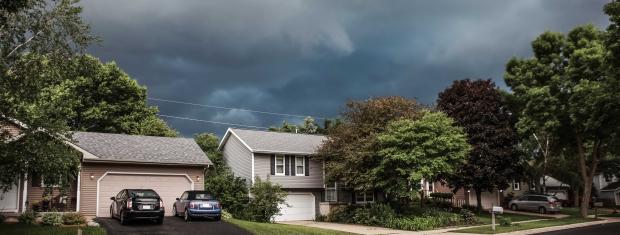
Severe Thunderstorms: Preparing for 5 Major Threats
Do you get just as nervous for a severe thunderstorm warning as you do a tornado warning? Everyone knows how seriously a tornado warning should be taken, but make no mistake, a severe thunderstorm warning should be taken just as seriously.
While a severe thunderstorm may not be capable of demolishing homes to a pile of rubble like a tornado can, they can certainly cause very devastating damage to your home and property. Severe thunderstorms are also dangerous and occasionally deadly.
There are 5 reasons you should never disregard a severe thunderstorm warning issued by the National Weather Service:
1. Destructive Winds
One of the most common forms of severe weather in the U.S. is caused by straight-line winds, not associated with tornadoes. These winds can at times exceed 100 mph, and unlike a tornado that is confined to more localized areas, straight-line winds tend to inflict damage on a much larger scale. Mass power outages are often a result of a large windstorm.
Damaging winds are classified as those exceeding 50-60 mph. Shingles can start flying off at around 70 mph. If your area receives a severe thunderstorm warning with winds close to or above these speeds, make sure you:
- Pick up any loose objects or furniture around your yard
- Check your trees for any low hanging branches that could be potentially hazardous, removing them if possible
- Reinforce your windows and doors with storm shutters
- Turn the temperature down on your fridge to help keep food from spoiling in the event of a power outage
- Update your emergency kit to include items such as blankets, entertainment, enough food and water for 3 days, copies of important documents, flashlights and extra batteries
2. Heavy Rains & Flooding
Heavy rains threaten some homeowners more than others. If you live in an area prone to flash-flooding, specifically a low-lying area close to bodies of water, a severe thunderstorm with heavy rain can pose a serious threat to your property.
There are a few things you can do to safeguard your home from heavy rains and potential flash flooding:
- Strengthen Your Window Wells
- Install (or have a contractor install) a sump pump
- Keep your gutters clean and free of debris
- Ensure your property is graded properly
- Build a barrier around your home with sandbags
Typically, flooding is a catastrophic loss for homeowners and it is excluded from your average Homeowners policy. We strongly encourage purchasing a separate flood insurance policy from FEMA to ensure your property is protected from such devastation.
3. Damaging Hail

Hailstones vary in size, ranging from small pinpoints to large baseball-sized hail. The majority of hailstones tend to be golf ball-sized or smaller, however, hail as small as 1” in diameter can damage roof shingles. Hail that reaches a golf ball size, roughly 1.75” in diameter, can put dents in your vehicle.
Damage quickly becomes more serious with more rare baseball-sized (smashes vehicle windshields) and softball-sized (punches holes in roofs) hail. Thunderstorms typically come with high winds that drive the hail at dangerous speeds.
Hail can cause a total loss to the exterior of your home destroying siding, adding numerous holes in your roof, even smashing windows. If hail is forecasted, be sure to move your vehicle(s) into a garage, parking deck or some covered area if you can.
4. Frequent Lightning
Lightning becomes dangerous when it travels from cloud-to-ground. Many mid-summer storms showcase heat lightning within the clouds above, but more severe storms feature lightning strikes that can threaten your home and your property.
When you notice cloud-to-ground lightning strikes, you should avoid contact with electrical devices, corded phones, metal pipes, etc. while taking shelter indoors. Stay inside for at least 30 minutes after hearing the last clap of thunder.
5. Tornado Formation
Sometimes a severe thunderstorm warning will include the following wording:
"Severe thunderstorms can and sometimes do produce tornadoes with little or no advance warning."
While a severe thunderstorm may not yet show sufficiently strong rotation on a doppler radar, it can certainly intensify in a matter of minutes and develop low-level rotation that under the right conditions, could lead to a tornado.
If a severe thunderstorm warning mentions the wording above, you would be wise to seek shelter as if it was a tornado warning, based on this potential for a tornado to quickly develop. It’s best to be prepared beforehand to stay safe throughout the storm.
Severe thunderstorms should never be taken lightly, especially as a homeowner. Being proactive and understanding the consequences of the major threats of a thunderstorm will help to keep you, your family, and your property safe.


